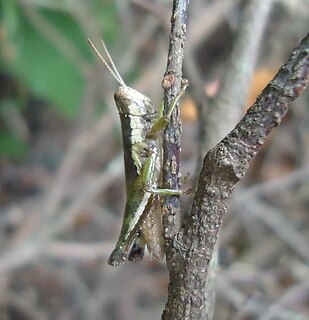
The Acrididae are the predominant family of grasshoppers, comprising some 10,000 of the 11,000 species of the entire suborder Caelifera. The Acrididae are best known because all locusts are of the Acrididae. The subfamily Oedipodinae is sometimes classified as a distinct family Oedipodidae in the superfamily Acridoidea. Acrididae grasshoppers are characterized by relatively short and stout antennae, and tympana on the side of the first abdominal segment.

Bandwings, or band-winged grasshoppers are the subfamily Oedipodinae of grasshoppers classified under the family Acrididae. They have a worldwide distribution and were originally elevated to full family status as the Oedipodidae. Many species primarily inhabit xeric weedy fields, and some are considered to be important locusts:

The grasshopper subfamily Acridinae, sometimes called silent slant-faced grasshoppers, belong of the large family Acrididae in the Orthoptera: Caelifera.

The Melanoplinae are a subfamily of grasshoppers in the family Acrididae. They are distributed across the Holarctic and Neotropic ecozones.

The Caelifera are a suborder of orthopteran insects. They include the grasshoppers and grasshopper-like insects, as well as other superfamilies classified with them: the ground-hoppers (Tetrigoidea) and pygmy mole crickets (Tridactyloidea). The latter should not be confused with the mole crickets (Gryllotalpidae), which belong to the other Orthopteran sub-order Ensifera.

Gomphocerini is a tribe of grasshoppers of the family Acrididae.

Atractomorpha is a genus in the Pyrgomorphidae, a family of grasshoppers, found in Africa, Asia, and Australia.

The Eneopterinae are a subfamily of crickets, in the family Gryllidae, based on the type genus Eneoptera. It is one of several groups widely described as "true crickets". Of the more than 500 species that make up this subfamily, most occur in moist, tropical habitats. These insects are medium to large and brown or gray in color. They eat plant leaves, flowers, and fruits and can occasionally cause economic damage. Their eggs are deposited in pith, bark, or wood. Eneopterinae show a great diversity in stridulatory apparatus, signals emitted, and associated behaviour.

Aiolopus is a genus of grasshopper belonging to the family Acrididae, subfamily Oedipodinae and tribe Epacromiini. Species can be found in Africa, Europe and Asia - through to New Caledonia.

Eumastacidae are a family of grasshoppers sometimes known as monkey- or matchstick grasshoppers. They usually have thin legs that are held folded at right angles to the body, sometimes close to the horizontal plane. Many species are wingless and the head is at an angle with the top of the head often jutting above the line of the thorax and abdomen. They have three segmented tarsi and have a short antenna with a knobby organ at the tip. They do not have a prosternal spine or tympanum. Most species are tropical and the diversity is greater in the Old World. They are considered primitive within the Orthoptera and feed on algae, ferns and gymnosperms, the more ancient plant groups.

The Cyrtacanthacridinae are a subfamily of Orthoptera: Caelifera in the family Acrididae. They are sometimes referred-to as bird locusts, criquets voyageurs in French-speaking Africa, and Knarrschrecken in German.

Podismini is a tribe of "spur-throated grasshoppers" in the family Acrididae. This tribe is unlike others in the subfamily Melanoplinae in that a substantial number of genera occur outside the Americas.

Pseudoxya diminuta is a species of grasshopper in the monotypic genus Pseudoxya.

Oedaleus is a genus of grasshoppers in the family Acrididae.

The Eyprepocnemidinae are a subfamily of Acrididae in the Orthoptera: Caelifera. Species can be found in Africa, mainland Europe and Asia.
Coptacra is the type genus of grasshoppers in the subfamily Coptacrinae. Species can be found in tropical Asia.

Stenocatantops is a genus of grasshoppers in the family Acrididae and subfamily Catantopinae. The recorded distribution of species includes: India, China, Indo-China and Malesia through to Australia.
Chlorophlaeoba is a genus of grasshoppers in the family Acrididae, subfamily Acridinae. Species can be found in southern China and Indo-China.
The Phaloriinae is a subfamily of crickets of the family Phalangopsidae. Species are terrestrial and are distributed in: Africa, tropical Asia, Korea, Australia and the Pacific Islands.
The Euscyrtinae are a subfamily of crickets, in the family Gryllidae, based on the type genus Euscyrtus. They are terrestrial and omnivorous and can be found in: Central America, Africa, Asia and Australia.




















